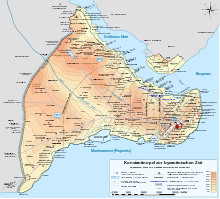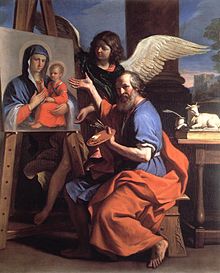Hodegon Monastery
The Hodegon monastery (from ancient Greek [ναὸς / μονὴ] τῶν Ὁδηγῶν , [ naos / monē ] tōn Hodēgōn , "[church / monastery] the guide"; also Hodegetria monastery , monastery tōn Hodēgōn or monastery of the Hodēgoi, called the) was a Christian Our Lady ( Theotókos ) consecrated male monastery , which was in Constantinople east of the Hagia Sophia . According to tradition, the monastery was founded by Empress Pulcheria in the 5th century . The Hodegon Monastery was originally under the Patriarchate of Constantinople , but was transferred to the Patriarchate of Antioch in 970 .
Written sources
Theodorus Lector (Anagnostes) reports that Empress Pulcheria had several churches built, including one to store and venerate an image of Our Lady with Child Jesus (→ Icon of Hodegetria ), which is said to have been created by the evangelist Luke . This description is only taken up again several centuries later by Nikephoros Callistus . In modern research, however, the authenticity of the passage in Theodorus Lector is questioned.
From around the 9th century, references to the Hodegon monastery are found more frequently. The later patriarch John VII Grammatikos is said to have been Anagnōstēs (Ἀναγνώστης) in the monastery of the Hodēgoi during the reign of Emperor Michael I (811-813) . According to the description of Joseph Genesios , an omen occurred in the "[monastery] of the Hodegoi" in 866 and announced the imminent death of Bardas . According to representation in the Patria Konstantinopuleos , the church was tōn Hodēgōn ( ancient Greek τῶν Ὁδηγῶν ) of Emperor Michael III. newly built or renovated; Before that, there was a miraculous spring there, where the blind were healed. The name of the church and the monastery is derived from the guides for the blind, the Hodēgoi ( ancient Greek Ὁδηγοι ).
An anonymous script with the title Logos diēgēmatikos ( ancient Greek Λόγος διηγηματικός ), which originated in the 13th century at the earliest, describes the history of the church of the Theotokós tōn Hodēgōn ( ancient Greek Θεοτόκος τῶν Ὁδηerγῶν. ) From a somewhat later perspective. In this work there is again the legend of the founding of the church by Pulcheria: The empress had received from Eudokia , the wife of Emperor Theodosius II , a picture of the Mother of God and the baby Jesus, which the evangelist Luke is said to have painted while Mary was still alive - the icon of Hodegetria.
Finally, Georgios Akropolites and Georgios Pachymeres describe the entry of Emperor Michael VIII. Palaiologos after the Byzantine reconquest of Constantinople in 1261 , when the icon of Hodegetria was carried at the head of the procession.
Also on a map of Constantinople in some manuscripts of the Liber insularum Archipelagi des Cristoforo Buondelmonti , such as Vat.Rossiano 702, Paris NAL 2383, Paris Latin 4823 and Paris Latin 4825, the Hodegon monastery (under the name Odigitria , Digitria , Chiramos , Chiramas or Chyramas , from ancient Greek κυρα μας “our mistress”).
Localization and archaeological evidence
The exact location of the Hodegon monastery within Constantinople has not been clarified with certainty. The representation in the Logos diēgēmatikos as well as a mention of the monastery by Niketas Choniates suggest that the monastery grounds were in the immediate vicinity of the sea (Marmara Sea or Bosphorus). According to written sources, especially the descriptions of contemporary pilgrims, the monastery was located east or south-east of Hagia Sophia.
During excavations in Gülhane Park , a niche round building and a structure interpreted as a hagiasma were uncovered (approximate position: 41 ° 0 ′ 33 ″ N , 28 ° 59 ′ 6 ″ E ), which could have been part of the monastery complex. Against this assumption, however, speaks that this area is northeast of Hagia Sophia, while the written sources rather suggest a southeastern position.
Importance of the monastery
The Hodegon monastery was - not least because of the icon of the Hodegetria kept there - an important destination for medieval pilgrims and travelers who visited Constantinople. In addition, the monastery housed a scriptorium in which a number of scribes known by name worked.
Icon of the Hodegetria
The icon of Hodegetria is characterized by its own pictorial program, in that the Mother of God carries the baby Jesus on her left arm and points to the child with her right. According to tradition, the portrait was painted by hand by the evangelist Luke and came to Constantinople in the fifth century. The icon was not only carried on processions and exhibited in the Hodegon Church; the image functioned as a kind of palladium of Constantinople. It was therefore placed on the city wall during sieges and carried on campaigns.
Scriptorium and Hodegon style
The Hodegon monastery had a scriptorium, in which its own writing style, the so-called Hodegon style , was developed in the 14th century . In the second half of the 13th century it was considered the only writing center in the Byzantine Empire that could afford the elaborate production of parchment manuscripts .
literature
- Christine Angelidi: Un texte patriographique et édifiant: Le “Discours narratif” on les Hodègoi . In: Revue des études byzantines . tape 52 , 1994, ISSN 0766-5598 , pp. 113–149 , doi : 10.3406 / rebyz.1994.1888 ( online [accessed July 20, 2013] cited as Angelidi (1994) ).
- Christine Angelidi, Titos Papamastorakis: The Veneration of the Virgin Hodegetria and the Monastery of the Hodegoi. In: Maria Vassilaki (ed.): Mother of God. The Representation of the Virgin in Byzantine Art [Benaki Museum, October 20, 2000 - January 20, 2001] . Skira, Milano 2000, ISBN 88-8118-738-8 , p. 373-387 ( cited as Angelidi (2000) ).
- Albrecht Berger : Investigations on the Patria Konstantinopuleos (= Poikila Byzantina; 8 ). Habelt, Bonn 1988, ISBN 3-7749-2357-4 , pp. 376-378 .
- Herbert Hunger , Otto Kresten : Archaic minuscule and Hodegon style in the 14th century . In: Yearbook of Austrian Byzantine Studies . tape 29 , 1980, ISSN 0378-8660 , p. 187-236 .
- Raymond Janin : Geographie ecclésiastique de l'Empire Byzantin; Vol. 1, part 3: Les églises et les monastères . 2nd Edition. Center National de la Recherche Scientifique, Paris 1969, p. 199-207 .
- Vassilios Kidonopoulos: Buildings in Constantinople 1204-1328: Decay and destruction, restoration, reconstruction and new construction of secular and sacred buildings (= Mainz publications on Byzantine Studies; 1 ). Harrassowitz, Wiesbaden 1994, ISBN 3-447-03621-4 , pp. 77-78 .
- Linos Politis : A writing school in the monastery T ΩΝ ΟΔΗΓΩ N (part 1) . In: Byzantine Journal . tape 51 , no. 1 , 1958, ISSN 0007-7704 , OCLC 1537961 , ZDB -ID 5800-2 , p. 17-36 , doi : 10.1515 / byzs.1958.51.1.17 .
- Linos Politis : A writing school in the monastery T ΩΝ ΟΔΗΓΩ N (part 2) . In: Byzantine Journal . tape 51 , no. 2 , 1958, p. 261-287 , doi : 10.1515 / byzs.1958.51.2.261 .
- Alice-Mary Talbot: Art. Hodegon Monastery . In: Alexander P. Kazdhan (Ed.): The Oxford Dictionary of Byzantium . Vol. 2. Oxford University Press, New York 1991, ISBN 0-19-504652-8 , pp. 939 .
Individual evidence
- ↑ Angelidi (2000), p. 376.
- ↑ Migne PG Vol. 86a, 564 (Col. 167 f); Church history, ed.Hansen 1995 2 , 367, 102.
- ↑ Migne PG Vol. 146, Col. 1061; 147, col. 44 A.
- ↑ Cyril Mango ( Constantinople as Theotokoupolis , in: Vassilaki, Mother of God , Milan 2000, pp. 17-25) considers the passage in Anagnostes to be a later interpolation (ibid. Fn. 15 and 58); Christine Angelidi assumes that the legendary tracing back of the Hodegetria to the Evangelist Luke did not arise before the ninth century (see Lit., Angelidi [2000], p. 377.); also doubtful A. Berger: Investigations on the Patria Konstantinopuleos , p. 376.
- ↑ Sancti Joannis Damasceni Epistola ad Theophilum Imperatorem de sanctis et venerandis imaginibus , Migne PG 95, 368A; Scriptor incertus de Leone Armenio , ed.Niebuhr (Bonn 1842), CSHB 31, p. 349.
- ^ Kaisergeschichte IV, 20: CFHB , vol. 14 (ed. Lesmüller-Werner / Thurn), p. 73, line 77; Migne PG 109, Sp. 1123. The work Theophanes Continuatus also describes this incident ( CSHB vol. 45, ed. Bekker 1838, p. 204).
- ↑ Patria Konstantinopuleos, III, 27: Preger (ed.), Scriptores originum Constantinopolitanarum (1907, ND 1989), p. 223; A. Berger, Investigations on the Patria Konstantinopuleos , 1988, p. 376.
- ↑ A. Berger, Investigations on the Patria Konstantinopuleos , 1988, p. 377 f .; Angelidi (see Lit., Angelidi (2000), p. 375).
- ↑ Text and French translation of the logo diēgēmatikos in Angelidi (1994) from page 134; see also Angelidi (2000), p. 375.
- ↑ Migne PG Vol. 140, p. 1218
- ↑ Rélationes historiques ( Relationes historicae ) ed. Failler / Laurent, CFHB 24/1, II, 31 (p. 217).
- ^ Città del Vaticano, FOT, Ross. 702 .
- ↑ Description of Ms. NAL 2383 of the Bibliothèque nationale de France .
- ^ Description of Ms. Latin 4823 of the Bibliothèque nationale de France .
- ^ Description of Ms. Latin 4825 of the Bibliothèque nationale de France .
- ↑ See the synoptic overview in Giuseppe Gerola , Le Vedute di Costantinopoli di Cristoforo Buondelmonti , in: Studi Bizantini e Neoellenici , 3 (1931), pp. 249-279, online , there p. 268 f. and p. 276; An enlarged section of the map from Ms. Vat. Rossiano 702 can be found in Demangel / Mamboury: Le quartier des Manganes et la première région de Constantinople , 1939, p. 110.
- ↑ See Berger, p. 377 f .; Kidonopoulos, p. 77 f.
- ↑ Angelidi (1994), p. 134 on the proximity of the sea.
- ↑ Migne PG Vol. 139, 698 (Col. 907).
- ↑ Texts in translation in George P. Majeska, Russian Travelers to Constantinople in the Fourteenth and Fifteenth Centuries , 1984, p. 362 ff.
- ^ So Robert Demangel, Ernest Mamboury : Le quartier des Manganes et la première région de Constantinople (Recherches françaises en Turquie, 2), Paris 1939, pp. 71–111.
- ↑ Kidonopoulos, p. 77 f.
- ↑ See e.g. B. Niketas Choniates , Migne PG Vol. 139, 497; 751
- ↑ See Herbert Hunger : Writing and Reading in Byzanz , Munich, p. 106.
- ↑ So Otto Kresten , The Relationships Between the Patriarchs of Constantinople and Antiocheia , Stuttgart 2000, p. 16 fn. 35.

